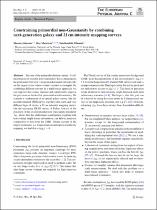| dc.contributor.author | Jolicoeur, Sheean | |
| dc.contributor.author | Maartens, Roy | |
| dc.contributor.author | Dlamini, Simthembile | |
| dc.date.accessioned | 2023-05-09T07:30:28Z | |
| dc.date.available | 2023-05-09T07:30:28Z | |
| dc.date.issued | 2023 | |
| dc.identifier.citation | Jolicoeur, S. et al. (2023). Constraining primordial non-gaussianity by combining next-generation galaxy and 21 cm intensity mapping surveys. European Physical Journal C, 83(4), 320. 10.1140/epjc/s10052-023-11482-2 | en_US |
| dc.identifier.issn | 1434-6052 | |
| dc.identifier.uri | 10.1140/epjc/s10052-023-11482-2 | |
| dc.identifier.uri | http://hdl.handle.net/10566/8904 | |
| dc.description.abstract | Surveys of the matter distribution contain ‘fossil’
information on possible non-Gaussianity that is generated in
the primordialUniverse. This primordial signal survives only
on the largest scales where cosmic variance is strongest. By
combining different surveys in a multi-tracer approach, we
can suppress the cosmic variance and significantly improve
the precision on the level of primordial non-Gaussianity.We
consider a combination of an optical galaxy survey, like the
recently initiated DESI survey, together with a new and very
different type of survey, a 21cm intensity mapping survey,
like the upcoming SKAO survey. | en_US |
| dc.language.iso | en | en_US |
| dc.publisher | SpringerOpen | en_US |
| dc.subject | Astrophysics | en_US |
| dc.subject | Astronomy | en_US |
| dc.subject | Cosmology | en_US |
| dc.subject | Physics | en_US |
| dc.subject | Galaxy evolution | en_US |
| dc.title | Constraining primordial non-gaussianity by combining next-generation galaxy and 21 cm intensity mapping surveys | en_US |
| dc.type | Article | en_US |

